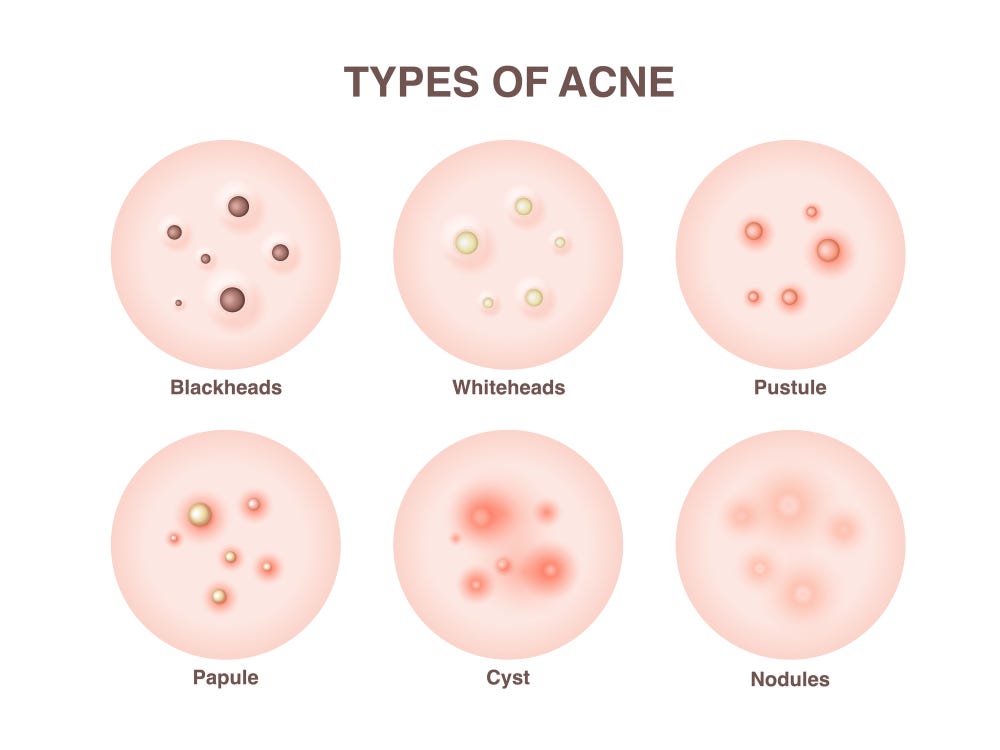Types of Acne
There are 6 different types of acne, and most of them affect the face, with some different or similar causes, symptoms, and treatment procedures.
The different types of acne include whiteheads, blackheads, pimples, papules, nodules, and cysts.
Each type of acne has distinctive symptoms, but they also tend to occur in different ways.
Here is a general description of each acne type, with their common symptoms and treatments.
Whitehead Acne
Whiteheads are a type of acne that’s probably easy to treat. The causes of whiteheads are dead skin cells, sebum, and dirt that get your pores clogged.
You can easily have blackheads if you consume high sugar and carbohydrates every day.
It’s simply the most noticeable and is characterized by closed pores, with clear, and whitehead-like dark spots that occur on your skin, mostly, the facial skin.
Whiteheads often develop at the opening of a sebaceous follicle (the gland that collects oil and dirt and stores it in the sebum of your skin).
Funny enough, whiteheads can turn to blackheads when they’re exposed to air, oxidized and it’s turned to black.
It’s advisable not to squeeze a whitehead in order not to break your skin and leave a permanent scar on your skin.
Whiteheads can be stubborn but can go away naturally and slowly. You can also get rid of whiteheads if you wash your face regularly with lukewarm water, exfoliate twice a week, and use sunscreen.
Nodule Acne
Nodules acne are small bump, painful and swollen pimples on the skin’s surface.
Nodules acne can be filled with pus, milky substance, bacteria, and inflamed, and it’s a severe type of acne.
When people that suffer from acne get rid of nodules, they usually get rid of their whiteheads too, at least temporarily.
Nodules acne is caused by bacteria, usually referred to as P. acne, when they’re trapped in clogged pores.
The bacteria now worsen the clogged pores and cause the above-mentioned symptoms of nodules acne.
To prevent or treat nodules acne at home, you should wash dirt from your face regularly, remove makeup before going to bed, use a lightweight moisturizer after cleaning your face, apply a clay mask to remove dead skin cells, oil, and bacteria from your skin pores, and wear SPF 30 sunscreen.
Since nodules are filled with a solid material, they can’t be popped, but you should gently remove them by pressing or squeezing them with a clean finger or cotton swab.
You can also use antibiotics and Azelaic acid in cases of severe nodule inflammation.
Blackhead Acne
Blackheads are similar to whiteheads, and the main difference is that blackheads have open pores while whiteheads are characterized by closed pores.
Blackheads are simple and easy to treat, although the whiteheads are not readily seen on the face.
The blackheads look like small pimples, but they’re filled with oxidized keratin (a protein that causes strong hair growth).
Because of this, blackheads are most common among people whose hormonal changes breakouts are caused by hormones (for example, teenagers who are undergoing puberty).
Blackheads acne is also known as hormonal acne, or acne vulgaris, and can occur in different parts of the body such as ears, back, and face, especially on the nose and cheeks.
The causes of blackhead acne are irritated hair follicles when dead skin cells are not cleaned, hormonal imbalance such as in pregnancy, menstruation, and puberty, and the over-production of the oil glands.
You can prevent and treat blackheads by following these practices
- Wash dirt from your face, and use toner or mild astringent
- Apply pressure around the pore or use pore strips so they pop out.
- Exfoliate with AHAs and BHAs twice a week
- Cleanse the area with salicylic acid or products with retinoids and non-comedogenic.
- Use oil-free sunscreen
Papule Acne
Papules are like nodules or pimples and they look like a tiny bump on the skin. A papule is caused by excess oil and skin cells that clog the pores.
Papules are not serious type of acne and it’s not readily seen in the beginning but can be filled with pus after about 1 week or can leave scars on your skin if you do not care about it.
Papules can occur on different parts of the body such as your legs, arms, or torso, but are not usually itchy unless it’s eczema.
Papule acne can also go away naturally on its own or with homemade treatments.
You should wash the area with lukewarm water, and remove the excess oil from the skin.
Over-the-counter soaps, ointments, and creams with salicylic acid can be very helpful in getting rid of papule acne from your skin.
Pimples
Pimples are a common type of acne. They are characterized by darm red and dark spots with pus, and occur when the hair follicles are blocked with dead skin cells or sebum, inflamed and consist of bacteria.
Pimples are common to people that have oily skin, and it’s the general symptom of acne.
The above-mentioned prevention and treatment methods for other types of acne are also applicable to pimples.
Cysts Acne
A cyst is a severe type of acne because it’s characterized by inflammation, pus-filled pimples on your skin, and can be very painful.
Nodules and cysts are also similar, but cystic acne is not common and can be very serious, the pores are blocked and usually lead to infection and inflammation of the skin.
The cysts that are formed underneath the skin are a combination of pus, oil and bacteria.
The treatment procedures, however, are similar to the treatment of other types of acne mentioned above in this article.
